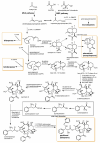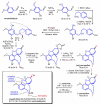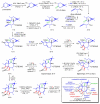Discovery and resupply of pharmacologically active plant-derived natural products: A review
- PMID: 26281720
- PMCID: PMC4748402
- DOI: 10.1016/j.biotechadv.2015.08.001
Discovery and resupply of pharmacologically active plant-derived natural products: A review
Abstract
Medicinal plants have historically proven their value as a source of molecules with therapeutic potential, and nowadays still represent an important pool for the identification of novel drug leads. In the past decades, pharmaceutical industry focused mainly on libraries of synthetic compounds as drug discovery source. They are comparably easy to produce and resupply, and demonstrate good compatibility with established high throughput screening (HTS) platforms. However, at the same time there has been a declining trend in the number of new drugs reaching the market, raising renewed scientific interest in drug discovery from natural sources, despite of its known challenges. In this survey, a brief outline of historical development is provided together with a comprehensive overview of used approaches and recent developments relevant to plant-derived natural product drug discovery. Associated challenges and major strengths of natural product-based drug discovery are critically discussed. A snapshot of the advanced plant-derived natural products that are currently in actively recruiting clinical trials is also presented. Importantly, the transition of a natural compound from a "screening hit" through a "drug lead" to a "marketed drug" is associated with increasingly challenging demands for compound amount, which often cannot be met by re-isolation from the respective plant sources. In this regard, existing alternatives for resupply are also discussed, including different biotechnology approaches and total organic synthesis. While the intrinsic complexity of natural product-based drug discovery necessitates highly integrated interdisciplinary approaches, the reviewed scientific developments, recent technological advances, and research trends clearly indicate that natural products will be among the most important sources of new drugs also in the future.
Keywords: Computer modeling; Drug discovery; Ethnopharmacology; Medicine; Natural products; Organic synthesis; Pharmacology; Phytochemistry; Plant biotechnology; Plants.
Copyright © 2015 The Authors. Published by Elsevier Inc. All rights reserved.
Figures






Similar articles
-
Modern Approaches in the Discovery and Development of Plant-Based Natural Products and Their Analogues as Potential Therapeutic Agents.Molecules. 2022 Jan 6;27(2):349. doi: 10.3390/molecules27020349. Molecules. 2022. PMID: 35056662 Free PMC article. Review.
-
Natural Products for Drug Discovery in the 21st Century: Innovations for Novel Drug Discovery.Int J Mol Sci. 2018 May 25;19(6):1578. doi: 10.3390/ijms19061578. Int J Mol Sci. 2018. PMID: 29799486 Free PMC article. Review.
-
Phytochemistry and pharmacognosy.Phytochemistry. 2007 Nov-Dec;68(22-24):2960-72. doi: 10.1016/j.phytochem.2007.06.028. Epub 2007 Aug 29. Phytochemistry. 2007. PMID: 17761200 Review.
-
Natural products as starting points for future anti-malarial therapies: going back to our roots?Malar J. 2011 Mar 15;10 Suppl 1(Suppl 1):S3. doi: 10.1186/1475-2875-10-S1-S3. Malar J. 2011. PMID: 21411014 Free PMC article. Review.
-
Roles of Medicinal Plants and Constituents in Gynecological Cancer Therapy: Current Literature and Future Directions.Curr Top Med Chem. 2020;20(20):1772-1790. doi: 10.2174/1568026620666200416084440. Curr Top Med Chem. 2020. PMID: 32297581 Review.
Cited by
-
Walnut extract protects against hepatic inflammation and toxicity induced by a high-fat diet.Food Sci Nutr. 2024 Sep 2;12(10):8340-8352. doi: 10.1002/fsn3.4405. eCollection 2024 Oct. Food Sci Nutr. 2024. PMID: 39479714 Free PMC article.
-
The workshops on computational applications in secondary metabolite discovery (CAiSMD).Phys Sci Rev. 2024 May 8;9(10):3289-3304. doi: 10.1515/psr-2024-0015. eCollection 2024 Oct. Phys Sci Rev. 2024. PMID: 39478877 Free PMC article. Review.
-
Insights into Osteogenesis Induced by Crude Brassicaceae Seeds Extracts: A Role for Glucosinolates.Nutrients. 2024 Oct 12;16(20):3457. doi: 10.3390/nu16203457. Nutrients. 2024. PMID: 39458452 Free PMC article.
-
Prevalence of Antidepressant Prescription in Adolescents Newly Diagnosed with Depression in Germany.Children (Basel). 2024 Oct 16;11(10):1246. doi: 10.3390/children11101246. Children (Basel). 2024. PMID: 39457211 Free PMC article.
-
Targeting Hypoglycemic Natural Products from the Cloud Forest Plants Using Chemotaxonomic Computer-Assisted Selection.Int J Mol Sci. 2024 Oct 10;25(20):10881. doi: 10.3390/ijms252010881. Int J Mol Sci. 2024. PMID: 39456663 Free PMC article.
References
-
- Actis-Goretta L, Leveques A, Giuffrida F, Romanov-Michailidis F, Viton F, Barron D, et al. Elucidation of (−)-epicatechin metabolites after ingestion of chocolate by healthy humans. Free Radic. Biol. Med. 2012;53:787–795. - PubMed
-
- Adams M, Schneider SV, Kluge M, Kessler M, Hamburger M. Epilepsy in the Renaissance: a survey of remedies from 16th and 17th century German herbals. J. Ethnopharmacol. 2012;143:1–13. - PubMed
-
- Adekenov SM, Muchametzhanov MN, Kagarlitskii AD, Kuprianov AN. Arglabin, a new sesquiterpene lactone from Artemisia glabella. Khim Prir Soedin. 1982:655–656.
-
- Afolayan AJ, Adebola PO. In vitro propagation: a biotechnological tool capable of solving the problem of medicinal plants decimation in South Africa. Afr. J. Biotechnol. 2004;3:683–687.
-
- Agarwal A, D'Souza P, Johnson TS, Dethe SM, Chandrasekaran C. Use of in vitro bioassays for assessing botanicals. Curr. Opin. Biotechnol. 2014;25:39–44. - PubMed
Publication types
MeSH terms
Substances
Grants and funding
LinkOut - more resources
Full Text Sources
Other Literature Sources
Miscellaneous


